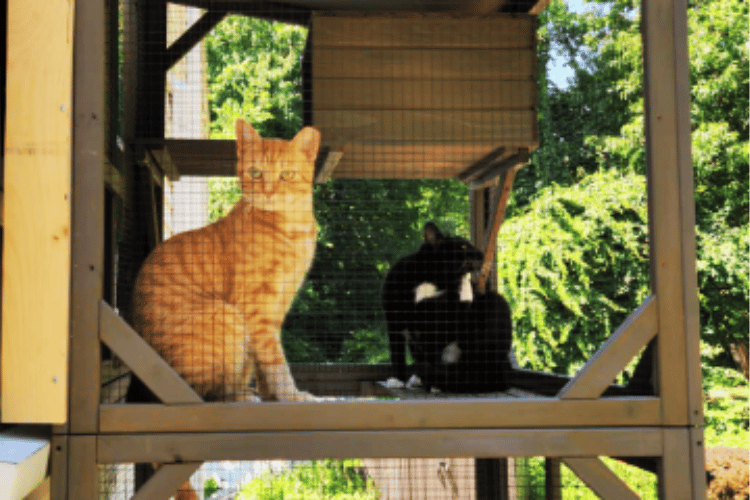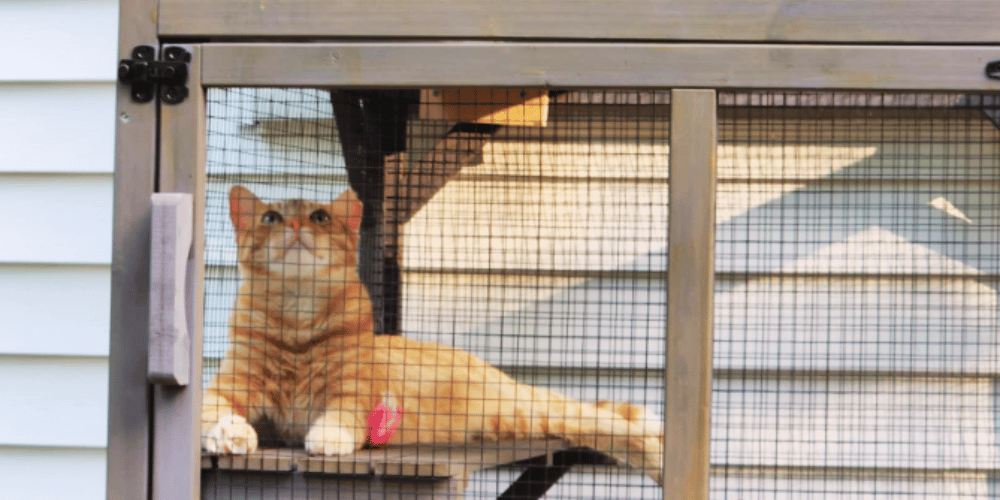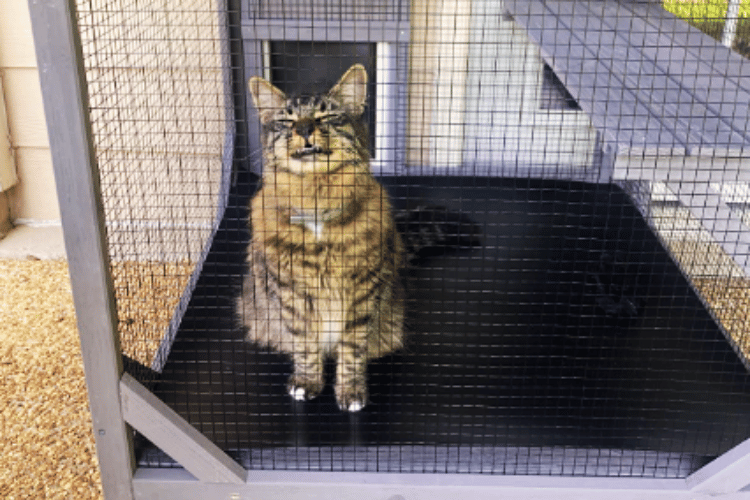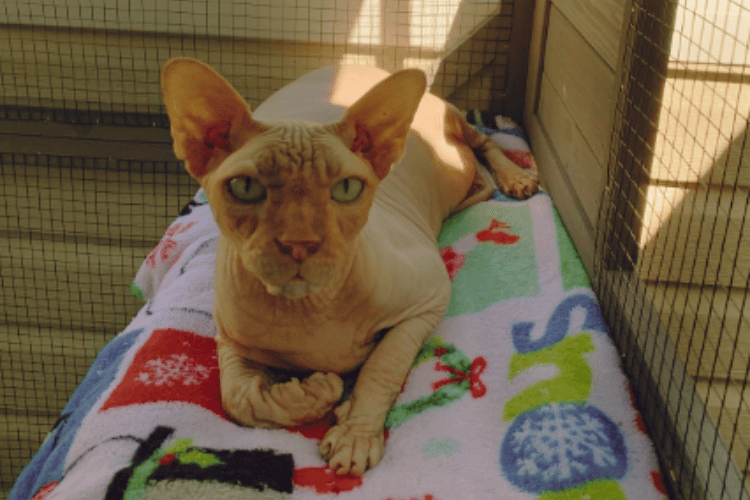Caring for our feline friends doesn't stop at the back door, especially for those who have outdoor cats or are looking after feral cat colonies. Providing a warm, safe, and comfortable outdoor cat house is crucial, particularly during the harsh weather of the winter season.
But what is the best bedding for an outdoor cat house? This comprehensive guide will walk you through the best options to keep your outdoor cat bed cozy and dry, ensuring your cats stay warm through snow, rain, and cold.
Key Takeaways:
- Straw makes excellent bedding for outdoor cat shelters, as it repels moisture and retains body heat.
- Avoid materials like hay, which can retain moisture and create a soggy mess, and opt for alternatives like mylar blankets or wood pallets.
- Regular maintenance of the bedding is essential; replace it with a new batch as seasons change to ensure a dry and clean environment.
Understanding the Needs of Outdoor Cats
Outdoor cats and feral cats require a safe haven to escape the elements. The ideal outdoor cat house filled with the right bedding can make a significant difference in keeping cats warm.
Bedding materials should be chosen with the ability to repel moisture and retain body heat in mind. During the winter season, these factors become even more critical as the risk of hypothermia increases.

Selecting the Right Bedding Material
When considering what is the best bedding for an outdoor cat house, straw is often the top recommendation. Straw makes excellent bedding because it repels moisture and helps keep cats warm by trapping their body heat.
Unlike hay, which generally costs less and is used to feed animals, straw does not retain moisture, which can lead to a soggy mess in the cat house.
The Downside of Hay and Other Materials
Hay may seem like a cost-effective option, but it's not suitable for bedding as it can retain moisture and promote mold growth, making the outdoor cat house damp and uncomfortable.
Other materials like old sleeping bags or memory foam padding might seem like good insulators, but they can also retain moisture and are difficult to keep clean.
The Benefits of Straw Bedding
Straw is not only great at keeping cats warm but it's also relatively inexpensive and can be found at most farm or tractor supply stores. It's important to loosely pack enough straw into the cat house to allow cats to burrow and create nests, which further helps to retain their body heat.
Creating a Cozy Retreat with Old Camping Gear
When it comes to keeping a feral cat house warm and inviting, don't overlook the potential of old camping gear. Many pet supply stores may offer specialized items, but sometimes the best solutions are already at hand.
An old sleeping bag, for instance, can be repurposed into a snug, insulated bed that retains heat. The long strands of synthetic or down filling mimic the insulating properties of commercial heated cat beds, providing a pocket of warmth for your outdoor feline friends.
Moreover, if you have an old tent or camping blankets, these can be cleverly converted into windbreaks or additional layers of warmth for the cat house. The waterproof materials used in camping gear are excellent for ensuring the bedding stays dry, which is crucial for maintaining warmth.
By repurposing these items, you not only save money but also provide a unique and effective solution to keep your cat warm through the colder months.
DIY Bedding Solutions from Home Supplies
Creating a comfortable space for your outdoor feline friend doesn't always require a trip to the pet supply store. With a bit of ingenuity, you can repurpose common household items into a cozy bedding solution.
Consider using old fleece blankets or sweatshirts that can provide warmth and comfort. These materials are soft, easy to wash, and can retain heat, making them an excellent choice for a heated cat bed. Ensure that any fabric you use is free of strings or small parts that could be ingested or cause harm to your cat.
Moreover, if you're handy with a needle and thread, you can fashion a custom heated bed by incorporating pockets for microwaveable heat pads. This method allows for a controlled heating element that can keep your outdoor cat warm even on the chilliest nights.
Remember to check the heat pads regularly to ensure they stay dry and functional. By using what you already have at home, you can provide a warm and inviting bed for your outdoor cat without breaking the bank.

The Importance of Dry Food Storage
When considering the well-being of an outdoor cat, it's not just about where they sleep but also how they eat. Proper food storage is crucial to ensure that your cat's food stays dry and fresh. A common mistake is leaving food out in the open, where it can become soggy from rain or snow.
Instead, invest in a weatherproof container that can protect the cat's food from the elements. This will help prevent the growth of mold and bacteria, which can be harmful to your cat's health.
Additionally, placing the food container near the cat house can encourage your pet to return regularly for meals and rest. This proximity can also make it easier for you to monitor food levels and refill as necessary. Some farm and pet supply stores offer specialized containers designed to keep pests out while allowing your cat easy access to their meals.
By ensuring a consistent supply of dry, healthy food, you're not only catering to your cat's nutritional needs but also reinforcing the safety and comfort of their outdoor home.
Harvesting Comfort: Utilizing Harvested Crops
In rural areas or if you have access to farmland, consider using dry leftover stalks from harvested crops as a bedding material. While hay generally costs less and is readily available, these stalks can be a free and efficient alternative.
They provide a similar texture and insulation to straw, helping to keep the cat warm. Ensure that the stalks are thoroughly dry to prevent mold and are free from any chemicals or pesticides that could harm your feline friend.
Shredded newspaper is another sustainable option that can be used as a makeshift blanket in a pinch. It's especially useful as a base layer at the halfway point of the cat house, where it can absorb any moisture and keep the long strands of straw or other bedding materials dry.
This method is not only cost-effective but also a great way to recycle paper. Just remember to replace the newspaper regularly to maintain a clean and dry environment for the cat.

Alternatives to Straw
For those looking for alternatives to straw, biodegradable packing peanuts can be used as they do not retain moisture and can provide extra warmth. Mylar blankets are another excellent choice; they reflect body heat back to the cat, providing additional warmth without the risk of becoming a soggy mess.
The Role of Insulation
Insulation is key in an outdoor cat house. Materials like styrofoam insulation or insulated tiles can help keep the interior of the cat house warm. A styrofoam cooler can also be repurposed as an outdoor cat shelter, as it naturally retains heat and repels moisture.
Heated Bedding Options
For those looking to provide additional warmth, heated cat beds and heating pads designed for outdoor use can be a safe and effective way to keep your feline friends warm. These should be used with caution and according to the manufacturer's instructions to prevent any risk of fire or injury.
Maintenance and Upkeep
Regular maintenance of the bedding is crucial. As the seasons change, remove old bedding and replace it with a new batch to ensure the cat house remains a dry place. This also helps to prevent the buildup of parasites and bacteria.
Protecting the Cat House from the Elements
To prevent rain and snow from getting into the cat house, make sure it's elevated off the ground, possibly with a wood pallet, and that the entrance is protected. Consider adding a flap or awning to shield the entrance from direct rain and snow.

Summary
Providing the best bedding for an outdoor cat house is essential for keeping your outdoor or feral cats warm and safe during the colder months. Straw is the top choice due to its moisture-repelling and heat-retaining properties.
Remember to avoid materials that retain moisture like hay, and consider alternatives like mylar blankets or biodegradable packing peanuts for extra warmth. Regular maintenance is key to ensuring a clean and dry environment for your cats.
By following these guidelines, you can create a cozy refuge that will help your outdoor cats weather the winter season comfortably.
FAQ Section
Can I use blankets or towels as bedding for an outdoor cat house?
While blankets and towels might seem like a cozy option, they can retain moisture and become a soggy mess, which is not ideal for keeping cats warm. It's better to use materials that repel moisture and provide better insulation, such as straw or mylar blankets.
How often should I change the bedding in an outdoor cat house?
It's recommended to change the bedding at least once per season or more frequently if it becomes wet or soiled. Regularly replacing the bedding helps to keep the cat house clean and dry, which is essential for the health and comfort of the cats.
Are heated cat beds safe for outdoor use?
Heated cat beds can be safe for outdoor use if they are specifically designed for that purpose and used according to the manufacturer's instructions. Always ensure that any electrical components are weatherproof and that the bed is placed in a location where it will remain dry.
Thank you for visiting LegitLists we hope this helps you make a legitimate choice!






